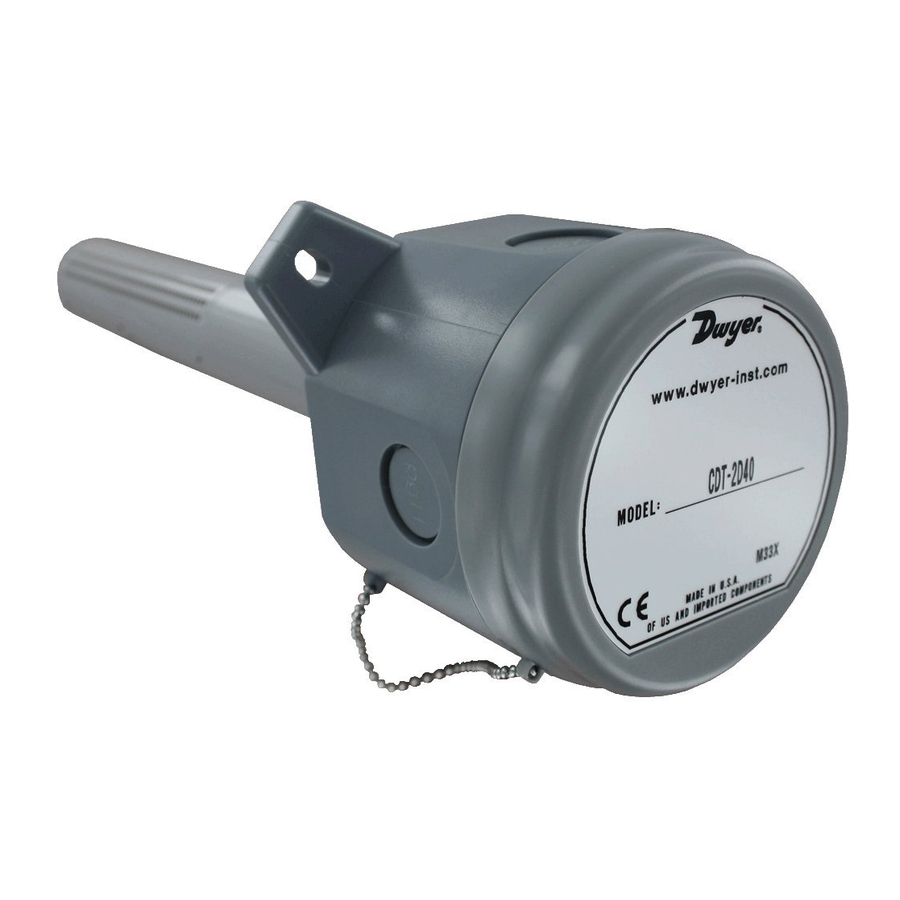Advertisement
Quick Links
Series CDT and CDTR Duct Mount Carbon Dioxide/
Temperature/Relative Humidity Transmitter
Specifications - Installation and Operating Instructions
Series CDT and CDTR Duct Mount Carbon Dioxide/ Temperature/Relative
Humidity Transmitters accurately monitor the CO
in schools, office buildings, and other indoor environments to help achieve LEED
certification. A non-dispersive infrared (NDIR) sensor is used to automatically correct
the measurement in both occupied and unoccupied buildings against aging effects. In
order to achieve a higher level of accuracy, the Series CDT includes digital barometric
pressure adjustment.
Universal outputs allow users to select the transmitter output to be 4-20 mA, 0-5 VDC
or 0-10 VDC to work with virtually any building management controller. An optional
relay with user adjustable set points can be used to control exhaust fans, open
actuated windows or dampers, or signal a light or horn.
For configuration purposes, the Series CDT and CDTR can be ordered with the Model
A-449 remote LCD display that can plug into the mini-connector port on the internal
circuit board. Menu items that can be accessed include: engineering units, relay output
set points, display configuration, transmitter output scaling, and ambient barometric
pressure.
Automated CO
Baseline Correction (ABC)
2
The Series CDT and CDTR CO
transmitters are maintenance free instruments
2
with the ability to adjust the CO
calibration by using the on-board ABC logic for
2
intermittently occupied spaces. The ABC algorithm accounts for long term drift by
making small adjustments to it's zero calibration point based on the lowest CO
readings it measures. CO
calibration adjustments are made every eight days by the
2
ABC algorithm. For environments occupied 24 hours per day it is recommended to
periodically expose the CO
sensor to outside ambient air.
2
DWYER INSTRUMENTS, INC.
P.O. BOX 373 • MICHIGAN CITY, INDIANA 46360, U.S.A.
1/8˝
[3.17]
Ø3-5/16˝
[84.14]
concentration and temperature
2
®
INSTALLATION
2
Make sure all connections are in accordance with the job wiring diagram and in
accordance with national and local electrical codes. Use copper conductors only.
transmitter to adjust to the current CO
days.
4-25/32˝
[121.44]
4-9/32˝
[108.74]
2-13/16˝
SPECIFICATIONS
Sensor: NDIR, 15 year life expectancy.
Range: CO
: 0 to 2000 or 0 to 5000 PPM (depending on model); RH: 0 to 100%
2
(for units configured with humidity output); Temperature: 32 to 122°F (0 to 50°C).
Accuracy*: ±40 PPM + 3% of reading (2000 PPM CO
(5000 PPM CO
); RH: ±2% (for units configured with humidity output); Temperature:
2
±1°C @ 25°C.
Response Time: 2 min for 90% step change.
Temperature Limits: 32 to 122°F (0 to 50°C).
Humidity Limits: 0 to 85% RH (non-condensing).
Power Requirements: 16-35 VDC/19-28 VAC.
Power Consumption: Average: 2 watts; Peak: 3.75 watts.
Output: Current: 4-20 mA (max 500 Ω); Voltage: 0-5 VDC or 0-10 VDC (min 500
Ω); Relay: SPST NO 2A @ 30 VDC; RTD or thermistor per r-t curves (depending on
model).
Weight: 5.6 oz (158.8 g).
Agency Approvals: CE.
*The specified CO
accuracy is only guaranteed after three weeks of continuous
2
operation in environments which are intermittently occupied.
Disconnect power supply before installation to prevent electrical
WARNING
shock and equipment damage.
Use electrostatic discharge precautions (e.g., use of wrist straps)
CAUTION
during installation and wiring to prevent equipment damage.
Avoid locations where severe shock or vibration, excessive
CAUTION
moisture or corrosive fumes are present.
Do not exceed ratings of this device, permanent damage not
CAUTION
covered by warranty may result.
NOTICE
Upon powering the transmitter, the firmware version will flash on
the display. A warm up period of 30 minutes is required for the
2
Self calibration feature of the transmitter requires exposure to
NOTICE
normal outdoor equivalent carbon dioxide level once every thirty
Phone: 219-879-8000
Fax: 219-872-9057
Bulletin AQ-CDT/CDTR-3
11-49/64˝
[298.85]
[71.44]
Ø1-15/64˝
[31.35]
); ±50 PPM + 5% of reading
2
concentration.
www.dwyer-inst.com
e-mail: info@dwyermail.com
Advertisement

Summary of Contents for Dwyer Instruments CDT Series
- Page 1 Self calibration feature of the transmitter requires exposure to NOTICE normal outdoor equivalent carbon dioxide level once every thirty days. DWYER INSTRUMENTS, INC. Phone: 219-879-8000 www.dwyer-inst.com P.O. BOX 373 • MICHIGAN CITY, INDIANA 46360, U.S.A. Fax: 219-872-9057 e-mail: info@dwyermail.com...
- Page 2 MOUNTING Current/Voltage Outputs 1. Cut hole into duct large enough to insert probe. The transmitter may be wired for current or voltage output for both carbon dioxide and 2. Attach housing ears to duct using the two self-tapping screws provided. temperature.
- Page 3 Menu Descriptions Maximum CO value Displays the highest CO concentration value observed by the sensor since Temperature low output range (CDT with active temperature only) the last power cycle or reset. Sets the temperature for the lowest output (4 mA or 0 VDC). Reset the MAX CO concentration by pressing and holding the ENTER button for 1 second.
- Page 4 Figure 5: Elevation chart Figure 6: Resistance vs temperature LEED is a registered trademark of the U.S. Green Building Council ® ©Copyright 2022 Dwyer Instruments, Inc. Printed in U.S.A. 3/22 FR# 444657-00 Rev. 1 DWYER INSTRUMENTS, INC. Phone: 219-879-8000 www.dwyer-inst.com P.O.















Need help?
Do you have a question about the CDT Series and is the answer not in the manual?
Questions and answers